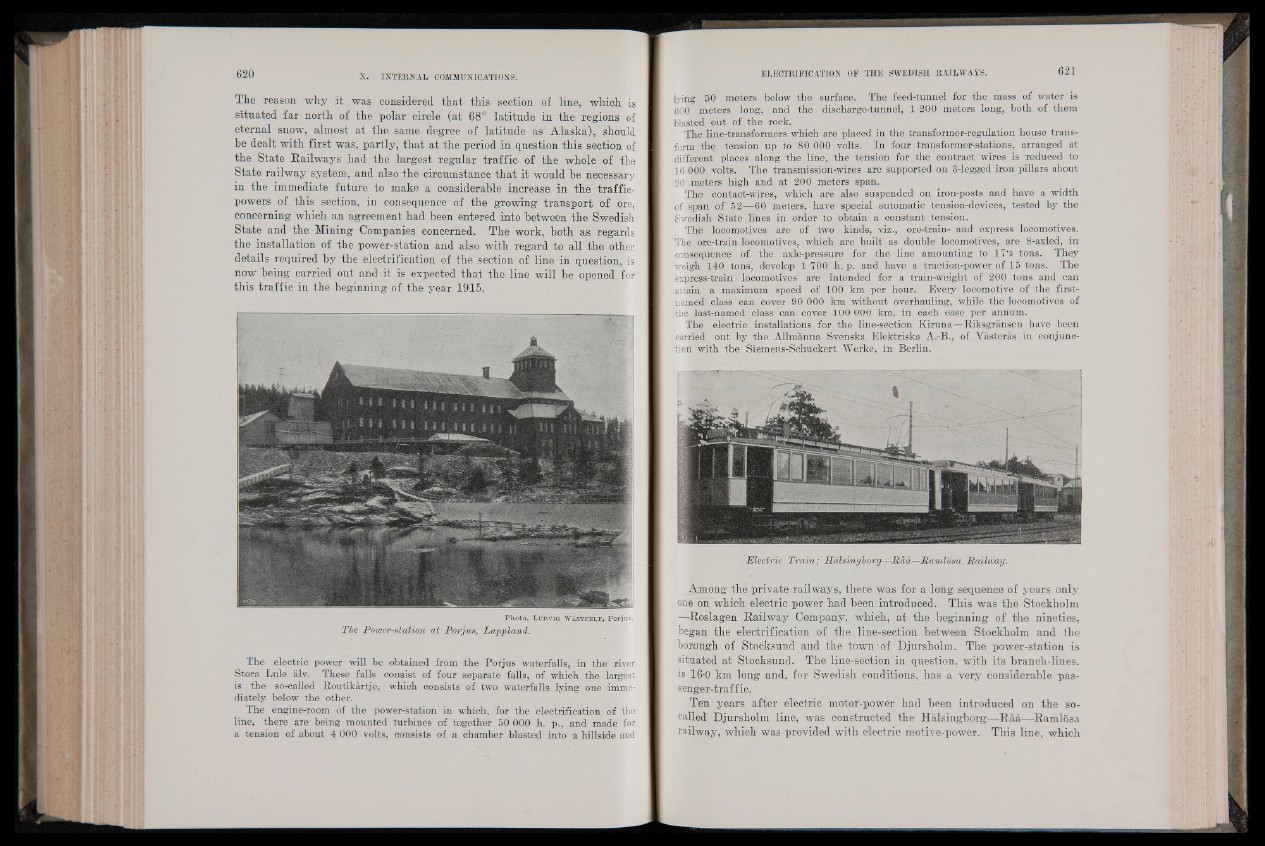
The reason why it was considered that this section of line, which is
situated far north of the polar circle (at 68° latitude in the regions of
eternal snow, almost at the same degree of latitude as Alaska), should
be dea-lt with first was, partly, that at the period in question this section of
the State Railways had the largest regular traffic of the whole of the
State railway system, and also the circumstance that it would be necessary
in the immediate future to make a considerable increase in the traffic-
powers of this section, in consequence of the growing transport of ore,
concerning which an agreement had been entered into between the Swedish
State and the Mining Companies concerned. The work, both as regards
the installation of the power-station and also with regard to all the other
details required by the electrification of the section of line in question, is
now being carried out and it is expected that the line will be opened for
this traffic in the beginning of the year 1915.
JL
P h o to . L u d v ig Wa s t f e l t , P o rju s .
The Power-station at Porjus, Lappland.
The electric power will be obtained from the Porjus waterfalls, in the river
Stora Lule alv. These falls consist of four separate falls, of which the largest
is the so-called Routikartje, which consists of two waterfalls lying one immediately
below the other.
The engine-room of the power-station in which, for the electrification of the
line, there are being mounted turbines of together 50 000 h. p., and made for
a tension of about 4 000 volts, consists of a chamber blasted into a hillside and
lying 50 meters below the surface. The feed-tunnel for the mass of water is
600 meters _ long, and the discharge-tunnel, 1 200 meters long, both of them
blasted out of the rock.
The line-transformers which are placed in the transformer-regulation house transform
the tension up to 80 000 volts. In four transformer-stations, arranged at
different places along the line, the tension for the contract wires is reduced to
16 000 volts. The transmission-wires are supported on 3-legged iron pillars about
20 meters high and at 200 meters span.
The contact-wires, which are also suspended on iron-posts and have a width
of span of 52—60 meters, have special automatic tension-devices, tested by the
Swedish State lines in order to obtain a constant tension.
The locomotives are of two kinds, viz., ore-train- and express locomotives.
The ore-train locomotives, which are built as- double locomotives, are 8-axled, in
consequence of the axle-pressure for the line amounting to 17'6 tons. They
weigh 140 tons, develop 1 700 h. p. and have a traction-power of 15 tons. The
express-train locomotives are intended for a train-weight of 200 tons and can
attain a maximum speed of 100 km per hour. Every locomotive of the first-
named class can cover 90 000 km without overhauling, while the locomotives of
the last-named class can cover 100 000 km, in each case per annum.
The electric installations for the line-seetion Kiruna—Riksgrànsen have been
carried, out by the Allmànna Svenska Elektriska A.-B., of Vasterâs in conjunction
with the Siemens-Schuckert Werke, in Berlin.
Electric Train; Halsingborg—Iîà â—Iiamlosa Railway.
Among the private railways, there was for a long sequence of years only
one on whibh electric power had been introduced. This was the Stockholm
—Roslagen Railway Company, which, at the beginning of the nineties,
began the electrification of the line-section between Stockholm and the
borough of Stocksund and the town • of Djursholm. The power-station is
situated at Stocksund. The line-section in question, with its branch-lines,
is 16-0 km long and, for Swedish conditions, has a very considerable passenger
traffic. -
Ten years after electric motor-power had been introduced on the so-
called Djursholm line, was constructed the Halsingborg—Rââ—Ramlosa
railway, which was provided with electric motive-power. This line, which